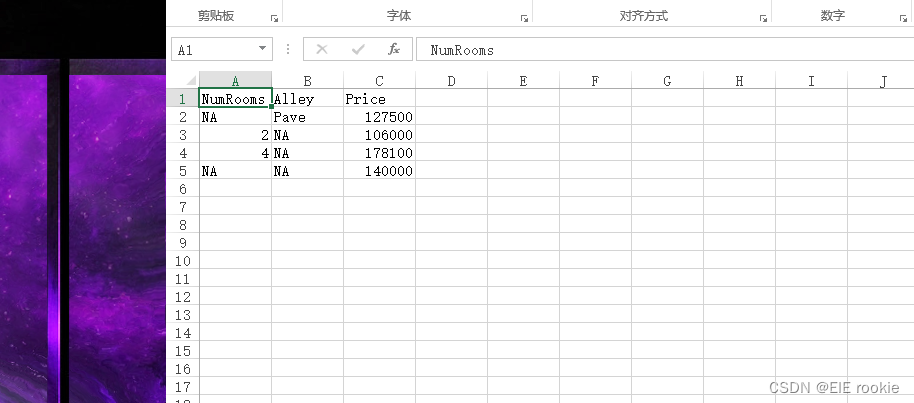已解决
pytorch第一天(tensor数据和csv数据的预处理)lm老师版
来自网友在路上 136836提问 提问时间:2023-10-02 02:08:16阅读次数: 36
最佳答案 问答题库368位专家为你答疑解惑
tensor数据:
import torch
import numpyx = torch.arange(12)
print(x)
print(x.shape)
print(x.numel())X = x.reshape(3, 4)
print(X)zeros = torch.zeros((2, 3, 4))
print(zeros)ones = torch.ones((2,3,4))
print(ones)randon = torch.randn(3,4)
print(randon)a = torch.tensor([[2, 1, 4, 3], [1, 2, 3, 4], [4, 3, 2, 1]])
print(a)exp = torch.exp(a)
print(exp)X = torch.arange(12, dtype=torch.float32).reshape((3, 4))
print(X)Y = torch.tensor([[2.0, 1, 4, 3], [1, 2, 3, 4], [4, 3, 2, 1]])
print(Y)print(torch.cat((X, Y), dim=0))#第一个括号 从外往里数第一个
print(torch.cat((X, Y), dim=1))#第二个括号 从外往里数第二个print(X == Y)#这也是个张量tosum = torch.tensor([1.0,2,3,4])
print(tosum.sum())#加起来也是tensor
print(tosum.sum().item())#这样就是取里面的数 就是一个数了
print(type(tosum.sum().item()))#打印一下类型 是float的类型a1 = torch.arange(3).reshape(3,1)
b1 = torch.arange(2).reshape(1,2)
print(a1+b1)#相加的时候 会自己填充相同的 boardcasting mechanismprint(X[-1])
print(X[1:3])X[1, 2] = 9 #修改(1,2)为9
print(X[1])#打印出那一行X[0:2] = 12 #这样的效果和X[0:2,:]=12是一样的 都是修改前两行为12
print(X)#id相当于地址一样的东西
#直接对Y操作改变了地址 增加了内存
before = id(Y)
Y = Y + X
print(id(Y) == before)
#对其元素修改操作 不增加内存 地址一样
Z = torch.zeros_like(Y)
print('id(Z):', id(Z))
Z[:] = X + Y
print('id(Z):', id(Z))#或者用+=连续操作 地址也不会变
before = id(X)
X += Y
print(id(X) == before)A = X.numpy()
print(A)
print("A现在的类型是:{}".format(type(A)))B = torch.tensor(A)
print(B)
print("B现在的类型是:{}".format(type(B)))运行结果自己对照学习了:
F:\python3\python.exe C:\study\project_1\main.py
tensor([ 0, 1, 2, 3, 4, 5, 6, 7, 8, 9, 10, 11])
torch.Size([12])
12
tensor([[ 0, 1, 2, 3],[ 4, 5, 6, 7],[ 8, 9, 10, 11]])
tensor([[[0., 0., 0., 0.],[0., 0., 0., 0.],[0., 0., 0., 0.]],[[0., 0., 0., 0.],[0., 0., 0., 0.],[0., 0., 0., 0.]]])
tensor([[[1., 1., 1., 1.],[1., 1., 1., 1.],[1., 1., 1., 1.]],[[1., 1., 1., 1.],[1., 1., 1., 1.],[1., 1., 1., 1.]]])
tensor([[-0.8680, 1.4825, -0.1070, -1.9015],[-0.7380, -0.3838, -0.2670, -0.2649],[ 0.9945, -1.5293, 0.0398, 0.1669]])
tensor([[2, 1, 4, 3],[1, 2, 3, 4],[4, 3, 2, 1]])
tensor([[ 7.3891, 2.7183, 54.5981, 20.0855],[ 2.7183, 7.3891, 20.0855, 54.5981],[54.5981, 20.0855, 7.3891, 2.7183]])
tensor([[ 0., 1., 2., 3.],[ 4., 5., 6., 7.],[ 8., 9., 10., 11.]])
tensor([[2., 1., 4., 3.],[1., 2., 3., 4.],[4., 3., 2., 1.]])
tensor([[ 0., 1., 2., 3.],[ 4., 5., 6., 7.],[ 8., 9., 10., 11.],[ 2., 1., 4., 3.],[ 1., 2., 3., 4.],[ 4., 3., 2., 1.]])
tensor([[ 0., 1., 2., 3., 2., 1., 4., 3.],[ 4., 5., 6., 7., 1., 2., 3., 4.],[ 8., 9., 10., 11., 4., 3., 2., 1.]])
tensor([[False, True, False, True],[False, False, False, False],[False, False, False, False]])
tensor(10.)
10.0
<class 'float'>
tensor([[0, 1],[1, 2],[2, 3]])
tensor([ 8., 9., 10., 11.])
tensor([[ 4., 5., 6., 7.],[ 8., 9., 10., 11.]])
tensor([4., 5., 9., 7.])
tensor([[12., 12., 12., 12.],[12., 12., 12., 12.],[ 8., 9., 10., 11.]])
False
id(Z): 1801869019800
id(Z): 1801869019800
True
[[26. 25. 28. 27.][25. 26. 27. 28.][20. 21. 22. 23.]]
A现在的类型是:<class 'numpy.ndarray'>
tensor([[26., 25., 28., 27.],[25., 26., 27., 28.],[20., 21., 22., 23.]])
B现在的类型是:<class 'torch.Tensor'>进程已结束,退出代码0
csv一般的数据预处理:
import os
import pandas as pd
import torch#创造文件夹 和excel csv文件
os.makedirs(os.path.join('..', 'data'), exist_ok=True)
data_file = os.path.join('..', 'data', 'house_tiny.csv')#因为没有 所有会自己创建一个#打开文件 用写的方式打开
with open(data_file, 'w') as f:f.write('NumRooms,Alley,Price\n')f.write('NA,Pave,127500\n')f.write('2,NA,106000\n')f.write('4,NA,178100\n')f.write('NA,NA,140000\n')#打开csv文件
data = pd.read_csv(data_file)
print(data) # 0,1,2,3会从第二行开始 因为第一行一般是标题和标签inputs, outputs = data.iloc[:, 0:2], data.iloc[:, 2]#裁剪0,1行 第2行舍去给input
print(inputs)
print(outputs)#name就会在下面inputs = inputs.fillna(inputs.mean())#把string的类型变成其他的均值
print(inputs)inputs = pd.get_dummies(inputs, dummy_na=True)#alley里面全是英文 应该把其编码 这就是编码的方式 是1就会为1
print(inputs)#都是数字后 就开始转换成tensor类型了
X, y = torch.tensor(inputs.values), torch.tensor(outputs.values)
print(X)
print(y)
运行结果:
F:\python3\python.exe C:\study\project_1\data_preprocess.py NumRooms Alley Price
0 NaN Pave 127500
1 2.0 NaN 106000
2 4.0 NaN 178100
3 NaN NaN 140000NumRooms Alley
0 NaN Pave
1 2.0 NaN
2 4.0 NaN
3 NaN NaN
0 127500
1 106000
2 178100
3 140000
Name: Price, dtype: int64NumRooms Alley
0 3.0 Pave
1 2.0 NaN
2 4.0 NaN
3 3.0 NaNNumRooms Alley_Pave Alley_nan
0 3.0 1 0
1 2.0 0 1
2 4.0 0 1
3 3.0 0 1
tensor([[3., 1., 0.],[2., 0., 1.],[4., 0., 1.],[3., 0., 1.]], dtype=torch.float64)
tensor([127500, 106000, 178100, 140000])进程已结束,退出代码0
第一行代码 创造文件夹的操作和csv操作结果:

他是跑到上一个级创建的dir

ok 结束
查看全文
99%的人还看了
相似问题
猜你感兴趣
版权申明
本文"pytorch第一天(tensor数据和csv数据的预处理)lm老师版":http://eshow365.cn/6-15636-0.html 内容来自互联网,请自行判断内容的正确性。如有侵权请联系我们,立即删除!
- 上一篇: 【分布式云储存】Springboot微服务接入MinIO实现文件服务
- 下一篇: QT使用前的知识